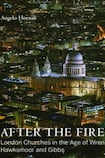
There must have been some sense of irony in London from the fact that the replacement churches for many of those destroyed in the Great Fire were funded by a coal tax. Frying pans and fires bring British foreign secretary Boris Johnson’s change in circumstances to mind these days. As calamitous as he was as lord mayor of the city, he could not top one of his predecessors Thomas Bludworth. When roused to deal with the Great Fire, which started on September 2nd, 1666, Bludworth dismissed it with a response not quite befitting public office: “a woman might piss it out”, he said, before returning to bed. No doubt he was far from gruntled, to use PG Wodehouse’s word, when he awoke.
In slight mitigation, small fires were a common occurrence at the time. But if Bludworth had been more of a jobsworth, then history might not have recorded the devastating outbreak that spread quickly and raged for four days. The catastrophe almost destroyed the entire city: at least 13,000 houses were lost, 87 parish churches were destroyed, including St Paul’s Cathedral, although the death toll was remarkably low. Fewer than 10 people were known to have died, but the figure was probably higher as many bodies would have been cremated in the intense heat; poor Londoners’ deaths would have gone unrecorded most likely.
In After The Fire, Angelo Hornak leaves the bodies (or lack of them) aside and focuses on the Baroque. Hornak details the huge rebuilding job of the London churches in the 60 years that followed the fire. It’s a lavish book filled with his impressive photography, which is accompanied by readable and unfussy architectural text. The publication is a hefty slab though, so it is unlikely to be used as a mobile reference for ambling from church to church (perhaps the publisher will include a digital download with future purchases?).
The 350th anniversary of the Great Fire of London will no doubt see a flurry of publications attached to it. The story of how Christopher Wren and his colleagues Robert Hooke, Nicholas Hawksmoor and James Gibbs, seized the opportunity of turning a city's devastation into a triumph by making it more beautiful is worth retelling in the context of the homogenisation of present-day architecture. The skills of these men, and the many others involved in the buildings, meant London was presented with one of the most idiosyncratic skylines in the world, thanks to joined-up government, openness to influences from European neighbours in Rome, Paris and the Netherlands, and a desire to build for spiritual enrichment, as much as economic necessity. An engraving by Johannes Kip from 1724 called A Prospect of the City of London captures the scene perfectly, with the many steeples of the rebuilt churches scattered like wayward children around St Paul's newly realised beauty: its father-figure dome.
Things could have been very different. When Wren was handed overall charge of the church-building programme (St James’s, Piccadilly is the only one he claimed to have solely designed, incidentally), his master plan proposed replacing medieval London with a new geometric grid, with grand avenues converging on the piazza at St Paul’s. Thankfully, the only elements of the plan stamped were the building of new quays along the Thames and the Fleet.
Speed was of the essence: the city had to be rebuilt quickly to maintain its dominance as a centre of commerce. Yet Hornak’s book shows how God, if He didn’t quite trump Mammon in making London the attraction it is today, played a supporting role in the city’s magnetism through this rich array of churches. Pull up a pew and savour it.











